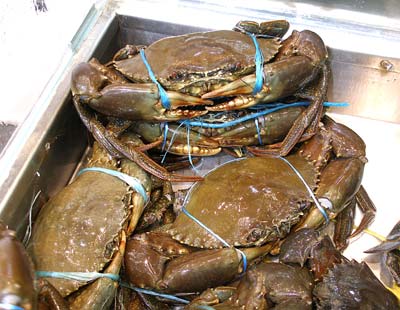
The mud crab or mangrove crab. A type of swimming crab found around the northern coasts of tropical Australia and making very good eating. It is found in the muddy bottoms around mangroves in estuaries and shallow bays. Only males are fished, usually using pots. They make very good eating indeed, although we found their musculature completely different from European crabs, with the meat not lifiting from the claws or from the carapace in a single succulent mouthful, but very flaky, requiring a great deal of thorough scraping to get at it. It is definitely worth the trouble as the flesh is remarkably sweet and well-flavoured. The colour of mud crabs will vary, as Denis Christie in Sydney Fish Market told me, depending on whether they have been caught in a sandy or muddy environments, those from mud being darker and greener. They are kept bound up when sold live, as they most frequently are, to prevent injury to other crabs. This crab, like so many others, has in the past been known as the black, brown of green crab, as well as the giant mud crab and, in error, the orange mud crab. When asked if he was going anywhere for his holidays, Stewart, one of the guides at the Bloomfield Lodge in Weary Bay in Northern Queensland replied that he was just going to stay put and fish a few mud crabs. A happy man.
Asian mussel. A variety of mussel with a greenish-black shell common in South East Asia. The meat is sometimes dried or fried and served as a snack food.
Calamondon of calamansi lime. A citrus fruit found in the Philippines though it is actually a hybrid and not found in the wild. Sour, small and round, it is often described as a cross between a tangerine or mandarin orange and a kumquat. It looks rather like a tangerine and is used to flavor foods and drinks